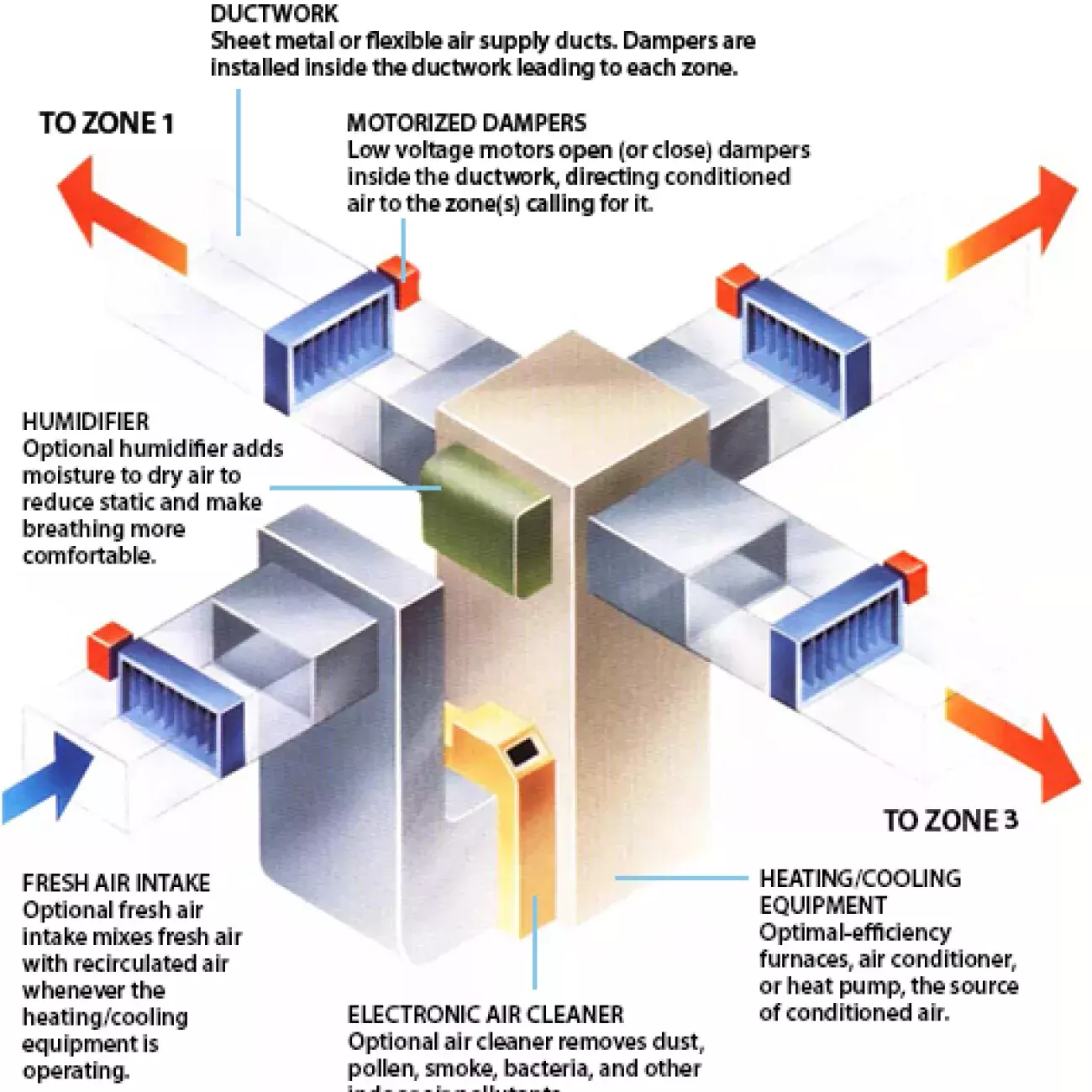Zoned Heating and Cooling
Homeowners use each room in a home differently. The size of each room, the level on which it sits, the direction it faces, how much window area there is, how the room is used, when the room is used, and who uses it are factors that affect the temperature and comfort level.
Zoning divides the house into areas with similar heating and cooling requirements. Homeowners can achieve improved comfort by controlling each zone with its own thermostat. Thermostat controlled motorized dampers control the flow of heating and cooling to each room from one central heating and cooling system.
Zoning allows users to:
- Improve comfort by adjusting the temperature in each room of the house
- Conveniently adjust the temperature in one room without having to go to another part of the house to adjust the central thermostat
- Use any type of thermostat
- Add automatic setback thermostats
- Turn back the temperature in rooms that are not in use
- Avoid having to use multiple HVAC units in order to provide zoning

How Zoning Works
A typical zone control system uses automatic duct dampers that open and close based on the demands of the thermostat for each zone. As the thermostat in each area requires conditioning, a signal is sent to a central control panel to activate the heating, cooling, and/or fan, based on the demand of that zone, or “call.” Conditioned air is directed only into the calling zones through the open dampers. The closed dampers shut off the air, preventing conditioned air from flowing into the satisfied zones. In some instances, based on duct design, excess conditioned air may need to be bypassed into the return or other non-critical common areas, such as hallways.
Zoning Myths
Zoning is only for new homes. Zoning can be installed on almost any type of HVAC system, new or existing.
Zoning is hard and complex to install. Zoning requires basic industry knowledge of airflow, duct design, and low voltage control wiring. Dampers simply install into the ducts and are connected with the zone thermostats to a central control panel that is wired to the HVAC unit.
Zoning is a new technology. Zone damper systems have been installed for over 50 years.
Standards and Guidelines
The Air Conditioning Contractors of America published Manual Zr in 2011 and serves as a resource for designing and installing zone systems. Learn more and order Manual Zr here.
Glossary of Terms
- Actuator: The “motor” that powers a damper. These may be Spring Return or Power Open/Power Closed.
- Auto Changeover: A system that will automatically switch from heating or cooling based on the needs of the home and predetermined set points.
- Bypass Damper: A damper installed in ductwork to regulate the static pressure on the supply side of ductwork.
- Capacity Control: A control designed to regulate the temperature in a duct system to prevent return air temperatures in the ductwork from going beyond preset temperatures that could potentially damage the compressor or heat exchanger.
- Communicating Thermostat: Any thermostat that sends and receives information from the HVAC system.
- Control Panel: The central controller of a zone control system. Typically this is where all control wiring terminates.
- Daisy Chain: A control system where the wiring goes from the Control Panel and sequentially to all other zones.
- Damper: A control device installed in the ductwork for regulating the flow of air.
- Home Base: A system where all zone wiring terminates at the Control Panel.
- Manual Changeover: A system that must be put into heat or cool mode by the user.
- Power Open/Power Closed: An operating mode of a damper actuator that requires power to open or close a damper.
- Purge Mode: An operating mode that allows the system to “normalize” before switching from heating to cooling or vice-versa.
- Spring return: An operating mode of the actuator of a damper that uses power to open or close a damper but a spring to return the damper to a fixed state.
AHRI Zone Control System Technology Product Section Members
Arzel Zoning Technology, Inc.
Carrier Corporation
EWC Controls
Honeywell International, Inc.
iO Systems
Lennox International Inc.
Research Products Corporation
Trane Technologies
Trolex Corporation